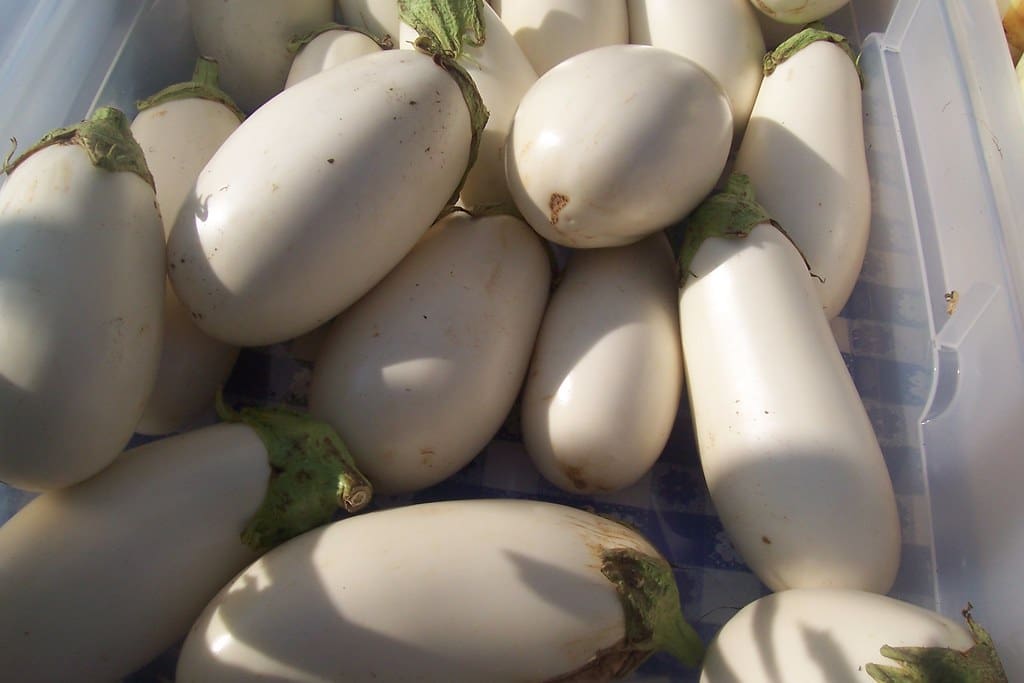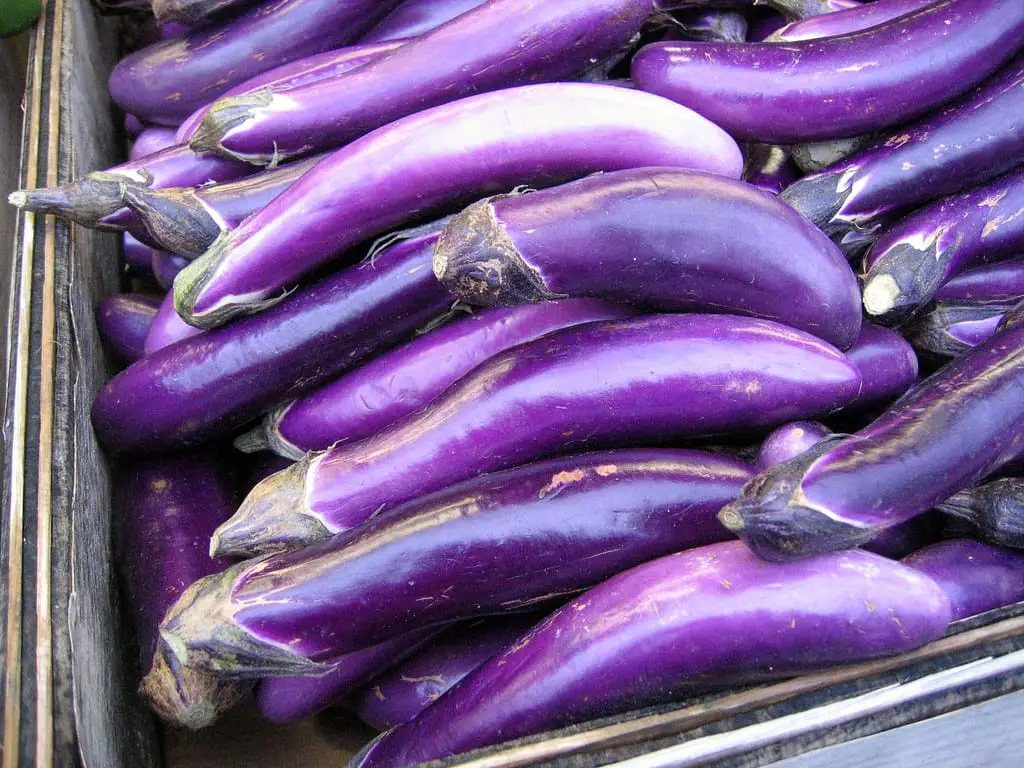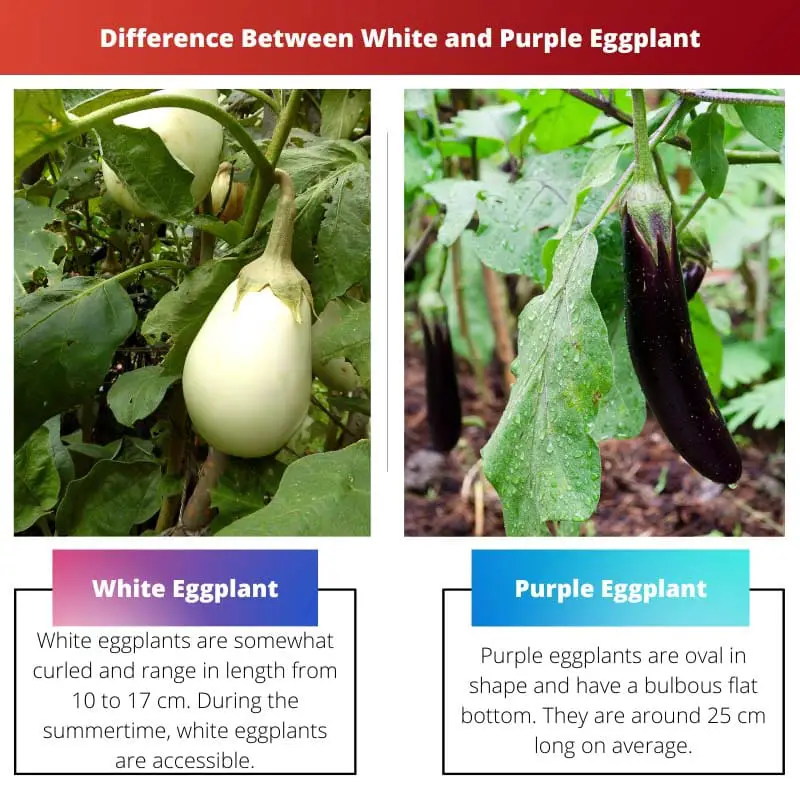Eggplant is a member of the nightshade genus. The eggplant is a tasty fruit that appears in a variety of hues. The eggplant is more commonly found in whitish and purple hues.
Nevertheless, when most people hear the word eggplant, the color purple comes immediately to mind. White eggplant, on the other hand, has now recently become popular as well.
Key Takeaways
- White eggplants have a milder flavor and thinner skin than purple eggplants.
- Purple eggplants contain higher levels of anthocyanins, which give them their color and offer various health benefits.
- Both varieties can be used interchangeably in recipes, but white eggplants may require a shorter cooking time.
White vs Purple Eggplant
The difference between white eggplant and purple eggplant is that white eggplants are considerably smaller than purple eggplants. White eggplants have more seeds and a firmer surface skin than purple eggplants, which have fewer seeds and smoother surface skin.

White eggplants are somewhat curled and range in length from 10 to 17 cm. During the summertime, white eggplants are accessible.
They include a lot of potassium as well as certain Vitamin b, magnesium, and copper. The skin on the outside is smooth and dazzling white. Their skins are tougher than those of purple varieties and must be scraped before preparing meals.
Purple eggplants are oval in shape and have a bulbous flat bottom. They are around 25 cm long on average. The surface layer is shiny and smooth, with a black-purple stem and a green stem.
Purple eggplants are soft and light when cooked, with a somewhat bitter flavor. They are prevalent all year, with a peak period in the summer.
Comparison Table
| Parameters of Comparison | White Eggplant | Purple Eggplant |
|---|---|---|
| Size | Smaller in size | Bigger in size |
| Number of Seeds | More seeds | Fewer seeds |
| Skin Texture | Harder skin | Softer skin |
| Peeling Skin | The skin must be removed before cooking. | Peeling the skin off is not always necessary |
| Taste | It is less bitter and creamier | It is more bitter |
What is White Eggplant?
White eggplants are somewhat curved and oblong in shape, ranging in length from 10 to 17 cm. The skin on the outside is smooth and dazzling white, with one bulbous end that tapers gently to a green calyx.
The cream-colored interior flesh is densely packed with delicious white seeds. White eggplants are creamy and gentle when cooked, having a faintly sweet taste.
White eggplant has been utilized in traditional medicine practices since 1330. Hu Sihui’s Yinshan Zhengyao, a Chinese treatise, displays concepts of safe eating and references text and imagery of eggplants.
In India, Ayurvedic medicine employs eggplant to cure sickness, and its roots are utilized to alleviate asthma symptoms.
White eggplants are indigenous to India and Bangladesh, where they have been farmed since antiquity. They were then transmitted along trade channels to Asia and Europe.
White eggplants are now available at specialized grocers and farmers’ markets throughout Asia, Europe, and the USA.
During the warmer months, they are prevalent. The beautiful eggplant is used exclusively for aesthetics and to offer a snowy-white tint to gardens. The widely domesticated eggplant is utilized in culinary recipes all over the continent.
White eggplants are rich in nutrients and include B vitamins, magnesium, and copper. They are properly prepared by stir-frying, frying, grilling, or baking. Their peels are tougher, and they must be scraped before food preparation.
As a side dish, with some other veggies, they can be diced and barbecued, fried, or even sautéed. They may also be diced and used as a meat replacement in spaghetti.
They have been used to accompany chiles, tomatoes, squash, stew meats, barbecued and baked fish, poultry, herbs, and cheeses like milk from cows, cheddar, and aged sheep’s cheese.

What is Purple Eggplant?
Purple eggplants are elliptical in shape with such a bulbous soft exterior that tightens more toward the crown and are around 25 centimeters long and 5-12 centimeters in diameter.
With a black-purple and a greenish stem, the outermost part is lustrous and smooth. The flesh on the interior is cream-colored and porous, containing many edible seeds. Purple eggplants cook soft and mild, with a quite bitter taste.
Purple eggplants are available year-round, with a peak season in the summer. They are the only genuine domesticated species, having been expelled from their wild ancestors.They are the most common kind in Western nations, and other forms of purple eggplant fall under their umbrella.
They are known to be quite high in potassium, fiber, and anthocyanins, which are mainly accountable for the purple pigmentation of the skin as well as antioxidant and anti-inflammatory effects.
Purple eggplants are best prepared, such as barbecuing, frying, baking, sautéing, and deep-frying. They’re commonly breaded and fried and used as a meat equivalent in pasta sauces and hamburgers.
Slow cooking them in stews and recipes with rice, meat, and veggies is also an option. Purple eggplants complement tomato, crushes, pepper, stew meats, barbecued and baked fish, poultry, beans, and lentils.
Purple eggplants can be kept in a cool, dry area for up to 3 days.

Main Differences Between White and Purple Eggplant
- White eggplants are smaller in size and purple eggplants are bigger in size.
- White eggplants have more seeds as compared to purple eggplants.
- White eggplants have a harder surface skin whereas purple eggplants have a softer skin.
- White eggplants are required to be peeled before cooking meanwhile purple eggplants don’t always require to be peeled.
- White eggplants are less bitter in taste while purple eggplants are more bitter in taste.




